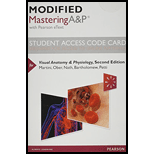
Modified MasteringA&P with Pearson eText -- Standalone Access Card -- for Visual Anatomy & Physiology (2nd Edition)
2nd Edition
ISBN: 9780321974013
Author: Frederic H. Martini, William C. Ober, Judi L. Nath, Edwin F. Bartholomew, Kevin Petti
Publisher: PEARSON
expand_more
expand_more
format_list_bulleted
Question
Chapter 18.2, Problem 2.1R
Summary Introduction
To compare: The content of oxygen in the two circulatory circuits.
Introduction: Blood is a liquid connective tissue that transports oxygen and essential nutrients throughout the body. It also carries away carbon dioxide and
Expert Solution & Answer
Want to see the full answer?
Check out a sample textbook solution
Students have asked these similar questions
explain Sudden cardiac arrest. in detail
Provide exmples.
Provide a diagram.
(a) Describe the process of erythropoiesis. (b) What name is given to the immature cell type released to the circulation? (c) How does it differ from a mature erythrocyte.
Explain the changes in blood pressure and potentialthrombus formation.
Chapter 18 Solutions
Modified MasteringA&P with Pearson eText -- Standalone Access Card -- for Visual Anatomy & Physiology (2nd Edition)
Ch. 18.1 - Prob. 1.1RCh. 18.1 - Prob. 1.2RCh. 18.1 - Prob. 1.3RCh. 18.1 - Prob. 2.1RCh. 18.1 - Prob. 2.2RCh. 18.1 - Prob. 2.3RCh. 18.1 - Prob. 3.1RCh. 18.1 - Prob. 3.2RCh. 18.1 - Prob. 3.3RCh. 18.1 - Prob. 4.1R
Ch. 18.1 - Prob. 4.2RCh. 18.1 - Prob. 4.3RCh. 18.1 - Prob. 1LOCh. 18.1 - Prob. 2LOCh. 18.1 - Prob. 3LOCh. 18.1 - Prob. 4LOCh. 18.1 - Prob. 1SRCh. 18.1 - Prob. 2SRCh. 18.1 - Prob. 3SRCh. 18.1 - Prob. 4SRCh. 18.1 - Prob. 5SRCh. 18.1 - Prob. 6SRCh. 18.1 - Prob. 7SRCh. 18.1 - Prob. 8SRCh. 18.1 - Prob. 9SRCh. 18.1 - Prob. 10SRCh. 18.1 - Prob. 11SRCh. 18.1 - Prob. 12SRCh. 18.1 - Prob. 13SRCh. 18.1 - Prob. 14SRCh. 18.1 - Prob. 15SRCh. 18.1 - Prob. 16SRCh. 18.1 - Prob. 17SRCh. 18.1 - Prob. 18SRCh. 18.1 - Prob. 19SRCh. 18.1 - Prob. 20SRCh. 18.1 - Prob. 21SRCh. 18.2 - Prob. 1.1RCh. 18.2 - Prob. 1.2RCh. 18.2 - Prob. 1.3RCh. 18.2 - Prob. 2.1RCh. 18.2 - Prob. 2.2RCh. 18.2 - C. Trace a drop of blood through the lungs,...Ch. 18.2 - Prob. 3.1RCh. 18.2 - Prob. 3.2RCh. 18.2 - Prob. 3.3RCh. 18.2 - Prob. 4.1RCh. 18.2 - Prob. 4.2RCh. 18.2 - Prob. 4.3RCh. 18.2 - Prob. 5.1RCh. 18.2 - Prob. 5.2RCh. 18.2 - Prob. 5.3RCh. 18.2 - Prob. 6.1RCh. 18.2 - Prob. 6.2RCh. 18.2 - Prob. 6.3RCh. 18.2 - Prob. 7.1RCh. 18.2 - Prob. 7.2RCh. 18.2 - Prob. 7.3RCh. 18.2 - Prob. 8.1RCh. 18.2 - Prob. 8.2RCh. 18.2 - Prob. 8.3RCh. 18.2 - Prob. 9.1RCh. 18.2 - Prob. 9.2RCh. 18.2 - Prob. 9.3RCh. 18.2 - Prob. 10.1RCh. 18.2 - Prob. 10.2RCh. 18.2 - Prob. 10.3RCh. 18.2 - Prob. 1LOCh. 18.2 - Prob. 2LOCh. 18.2 - Prob. 3LOCh. 18.2 - Prob. 4LOCh. 18.2 - Prob. 5LOCh. 18.2 - Prob. 6LOCh. 18.2 - Prob. 7LOCh. 18.2 - Prob. 8LOCh. 18.2 - Prob. 9LOCh. 18.2 - Prob. 10LOCh. 18.2 - Prob. 1SRCh. 18.2 - Prob. 2SRCh. 18.2 - Prob. 3SRCh. 18.2 - Prob. 4SRCh. 18.2 - Prob. 5SRCh. 18.2 - Prob. 6SRCh. 18.2 - Prob. 7SRCh. 18.2 - Prob. 8SRCh. 18.2 - Prob. 9SRCh. 18.2 - Prob. 10SRCh. 18.2 - Prob. 11SRCh. 18.2 - Prob. 12SRCh. 18.2 - Prob. 13SRCh. 18.2 - Prob. 14SRCh. 18.2 - Prob. 15SRCh. 18.2 - Label the major veins in the diagram below.
16...Ch. 18.2 - Prob. 17SRCh. 18.2 - Prob. 18SRCh. 18.2 - Prob. 19SRCh. 18.2 - Prob. 20SRCh. 18.2 - Prob. 21SRCh. 18.2 - Prob. 22SRCh. 18.2 - Prob. 23SRCh. 18.2 - Prob. 24SRCh. 18.2 - Prob. 25SRCh. 18.2 - Prob. 26SRCh. 18.2 - Prob. 27SRCh. 18.2 - Prob. 28SRCh. 18 - Prob. 1CRQCh. 18 - Prob. 2CRQCh. 18 - Prob. 3CRQCh. 18 - Prob. 4CRQCh. 18 - Prob. 5CRQCh. 18 - Prob. 6CRQCh. 18 - Prob. 7CRQCh. 18 - Prob. 8CRQCh. 18 - Prob. 9CRQCh. 18 - Prob. 10CRQCh. 18 - Prob. 11CRQCh. 18 - Prob. 12CRQCh. 18 - Prob. 13CRQCh. 18 - Prob. 14CRQCh. 18 - Prob. 15CRQCh. 18 - Prob. 16CRQCh. 18 - Prob. 17CRQCh. 18 - Prob. 18CRQCh. 18 - Prob. 19CRQCh. 18 - Prob. 1CICh. 18 - Prob. 2CICh. 18 - Prob. 3CI
Knowledge Booster
Similar questions
- Explain how reduced blood flow in an area can interfere withhealing and increase the risk of infection.arrow_forward(a) Describe how heart contraction and relaxation influence coronary blood flow. (b) Name the major branches of the coronary arteries, and note the heart regions served by each.arrow_forwardExplain the clinical significance of both high and low mean arterial pressure (MAP).arrow_forward
- (b) Explain why the colloid osmotic pressure of the plasma is much higher than the colloid osmotic pressure of interstitial fluid and why this is important in ensuring excess tissue fluid does not accumulate to cause edema.arrow_forwardIdentify/describe the structure of the pericardium. Describe its function.arrow_forward
arrow_back_ios
arrow_forward_ios
Recommended textbooks for you
 Human Physiology: From Cells to Systems (MindTap ...BiologyISBN:9781285866932Author:Lauralee SherwoodPublisher:Cengage Learning
Human Physiology: From Cells to Systems (MindTap ...BiologyISBN:9781285866932Author:Lauralee SherwoodPublisher:Cengage Learning

Human Physiology: From Cells to Systems (MindTap ...
Biology
ISBN:9781285866932
Author:Lauralee Sherwood
Publisher:Cengage Learning